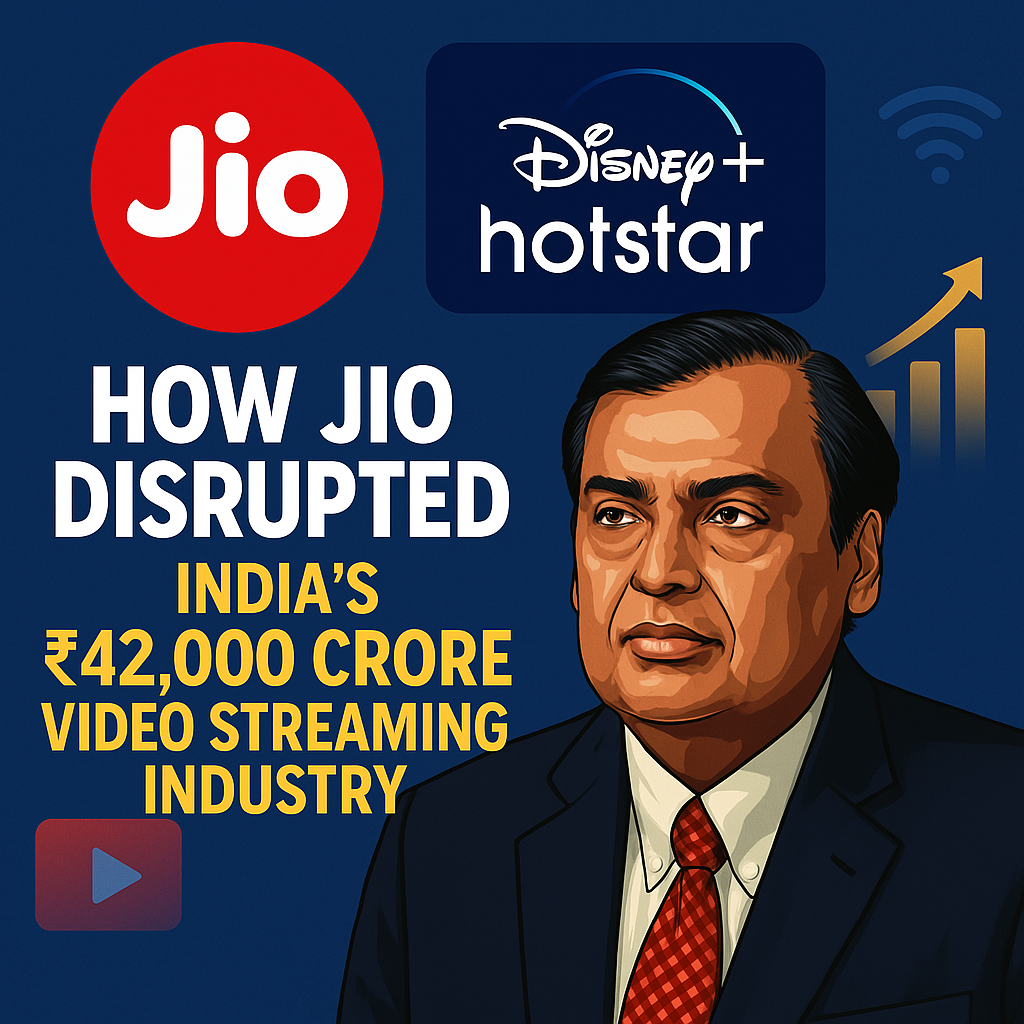The Massive Merger: Jio and Disney
Last month, Jio announced a ₹70,000 crore merger with Disney—a deal that will give Reliance monopolistic power in India’s massive online entertainment industry. A calculated business move to control 85% of India’s streaming audience, 60% of the Indian media landscape, and about 30% of the OTT market share.
A masterstroke by Reliance to create an OTT monopoly that becomes impossible to ignore. It’s the execution of a precise three-part playbook that Mukesh Ambani already used once with Jio Telecom. Now he’s applying the same formula to take over your entertainment.
Why Hotstar Merged with JioCinema
Now before we begin—welcome to Growth X. We are a community of 4,000 members from India’s top technology companies. Also, we are now part of the 01 Network by Zerodha. Now let’s get back to the episode.
You have likely seen plenty of content explaining the context behind this merger, so we won’t go over that. Instead, let’s focus on key insights.
The first question that comes to mind is: Why did Hotstar merge with its biggest competitor? And more importantly, even after losing major assets like IPL and HBO, why would JioCinema acquire a company that’s never been profitable?
Disney’s Exit and Reliance’s Opportunity
Despite being in India for over eight years, Hotstar didn’t make a single rupee in profit. By 2022, when Disney’s global revenue was ₹6,50,000 crore, its Indian business made only ₹3,200 crore—just 0.5% of Disney’s overall business.
So for Disney, it made little sense to divert resources to India when it can earn 10x ARPU in the West.
For Reliance, this was an opportunity to take over by acquiring three key assets:
1. High Engagement Content
Sports and serials are high-frequency media. Jio had IPL, but it’s seasonal. Acquiring serials, Kabaddi, Bigg Boss, etc., creates a consistent daily content habit.
2. Infrastructure
Jio faced criticism for poor streaming quality and UI. Hotstar, however, set records—like 4.3 crore concurrent viewers during the 2023 ICC World Cup.
3. Premium Subscriber Base
By end-2024, Hotstar had around 40 million paid subscribers, providing JioCinema a ₹2,500 crore/year premium stream.
Jio’s Disruptive Pricing and Hybrid Revenue Model
Let’s dive into deeper insights on how Jio plans to make this profitable:
Aggressive Pricing Strategy
Like it did with telecom, Jio is disrupting OTT with ultra-low pricing. With plans as low as ₹50/month, Jio is going mass-market, especially for India’s 650 million smartphone users—80% of whom watch OTT on mobile.
Hybrid Revenue Model (AVOD + SVOD)
Jio is keeping Hotstar’s model:
- AVOD (Ad-supported Video on Demand): Free content supported by ads
- SVOD (Subscription Video on Demand): Paid ad-free and exclusive content
In India, ads are a natural part of the viewing experience. AVOD grew 21% while SVOD declined 2%, giving Jio a major edge over Netflix and Prime.
Content Library Monopoly
With 120+ TV channels, 3 lakh hours of content, and all top-tier sports/events, Jio has become a content powerhouse.
Full Control Over OTT Sports & Ad Revenue
Jio now controls 80% of the OTT sports market—including IPL, ICC tournaments, Wimbledon, Pro Kabaddi, and ISL. Advertisers now have no choice but to go through Jio.
This boosts user retention and gives Jio pricing control in the ad market.
Bundling Power: The Ultimate Moat
Jio’s strategy: Access first, affordability next.
With 480 million subscribers, Jio can bundle data and OTT, reducing churn. Users won’t switch telecom providers if they lose their entertainment bundle.
Unlike Hotstar, which had to recover content costs via ads, Reliance can afford to play long-term. It has deep pockets and many other businesses to cross-monetize.
Why Jio Will Win Even If It’s Not Profitable (Yet)
Hotstar had a $0.60 ARPU—10x lower than Disney+ globally. Jio’s ₹50/month plans might seem unviable, but:
Reliance isn’t just a media company. It can absorb losses, cross-sell, and scale like no other player in India.
Conclusion: The Billion-Dollar Play for Entertainment Dominance
This isn’t just a merger. It’s Reliance building an unstoppable ecosystem—data + content, priced for mass India, and built for long-term domination. No other OTT/media company in India has this level of leverage.
Now you know everything about the biggest media deal of the decade.
Frequently Asked Questions (FAQs)
❓ Why did Disney exit India’s OTT market?
Disney wasn’t generating significant profits from India, and the ARPU was much lower compared to Western markets. It made more business sense to partner with a local giant like Reliance.
❓ What is AVOD vs SVOD?
- AVOD: Users watch free content with ads (Ad-based).
- SVOD: Users pay for ad-free and exclusive content (Subscription-based).
❓ How does Jio benefit from this merger?
Jio gains access to Hotstar’s premium content, existing subscriber base, and proven infrastructure—all while leveraging its own massive telecom user base for scale.
❓ Will Jio dominate OTT in India?
Yes. With control over 80% of sports streaming, a vast content library, and competitive pricing, Jio is on track to dominate India’s OTT space.










